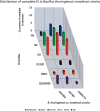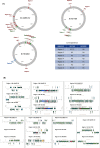Role of plasmid plasticity and mobile genetic elements in the entomopathogen Bacillus thuringiensis serovar israelensis
- PMID: 30203090
- PMCID: PMC6199540
- DOI: 10.1093/femsre/fuy034
Role of plasmid plasticity and mobile genetic elements in the entomopathogen Bacillus thuringiensis serovar israelensis
Abstract
Bacillus thuringiensis is a well-known biopesticide that has been used for more than 80 years. This spore-forming bacterium belongs to the group of Bacillus cereus that also includes, among others, emetic and diarrheic pathotypes of B. cereus, the animal pathogen Bacillus anthracis and the psychrotolerant Bacillus weihenstephanensis. Bacillus thuringiensis is rather unique since it has adapted its lifestyle as an efficient pathogen of specific insect larvae. One of the peculiarities of B. thuringiensis strains is the extent of their extrachromosomal pool, with strains harbouring more than 10 distinct plasmid molecules. Among the numerous serovars of B. thuringiensis, 'israelensis' is certainly emblematic since its host spectrum is apparently restricted to dipteran insects like mosquitoes and black flies, vectors of human and animal diseases such as malaria, yellow fever, or river blindness. In this review, the putative role of the mobile gene pool of B. thuringiensis serovar israelensis in its pathogenicity and dedicated lifestyle is reviewed, with specific emphasis on the nature, diversity, and potential mobility of its constituents. Variations among the few related strains of B. thuringiensis serovar israelensis will also be reported and discussed in the scope of this specialised insect pathogen, whose lifestyle in the environment remains largely unknown.
Figures











Similar articles
-
Interspecies Horizontal Transfer and Specific Integration of the Mosquitocidal Toxin-Encoding Plasmid pTAND672-2 from Bacillus thuringiensis subsp. israelensis to Lysinibacillus sphaericus.Appl Environ Microbiol. 2023 Feb 28;89(2):e0165222. doi: 10.1128/aem.01652-22. Epub 2023 Feb 7. Appl Environ Microbiol. 2023. PMID: 36749061 Free PMC article.
-
pXO16, the large conjugative plasmid from Bacillus thuringiensis serovar israelensis displays an extended host spectrum.Plasmid. 2019 Mar;102:46-50. doi: 10.1016/j.plasmid.2019.02.004. Epub 2019 Feb 27. Plasmid. 2019. PMID: 30825469
-
Comparative genomics of extrachromosomal elements in Bacillus thuringiensis subsp. israelensis.Res Microbiol. 2017 May;168(4):331-344. doi: 10.1016/j.resmic.2016.10.008. Epub 2016 Nov 1. Res Microbiol. 2017. PMID: 27810477
-
Occurrence and diversity of mosquitocidal strains of Bacillus thuringiensis.J Vector Borne Dis. 2005 Sep;42(3):81-6. J Vector Borne Dis. 2005. PMID: 16294805 Review.
-
Insect pathogens as biological control agents: Back to the future.J Invertebr Pathol. 2015 Nov;132:1-41. doi: 10.1016/j.jip.2015.07.009. Epub 2015 Jul 27. J Invertebr Pathol. 2015. PMID: 26225455 Review.
Cited by
-
Interspecies Horizontal Transfer and Specific Integration of the Mosquitocidal Toxin-Encoding Plasmid pTAND672-2 from Bacillus thuringiensis subsp. israelensis to Lysinibacillus sphaericus.Appl Environ Microbiol. 2023 Feb 28;89(2):e0165222. doi: 10.1128/aem.01652-22. Epub 2023 Feb 7. Appl Environ Microbiol. 2023. PMID: 36749061 Free PMC article.
-
Genomic insights into the diversity of non-coding RNAs in Bacillus cereus sensu lato.Curr Genet. 2022 Aug;68(3-4):449-466. doi: 10.1007/s00294-022-01240-4. Epub 2022 May 12. Curr Genet. 2022. PMID: 35552506
-
Bacillus cytotoxicus Genomics: Chromosomal Diversity and Plasmidome Versatility.Front Microbiol. 2021 Dec 9;12:789929. doi: 10.3389/fmicb.2021.789929. eCollection 2021. Front Microbiol. 2021. PMID: 34992589 Free PMC article.
-
Long inverted repeats around the chromosome replication terminus in the model strain Bacillus thuringiensis serovar israelensis BGSC 4Q7.Microb Genom. 2020 Dec;6(12):mgen000468. doi: 10.1099/mgen.0.000468. Epub 2020 Nov 12. Microb Genom. 2020. PMID: 33180015 Free PMC article.
-
A small bacteriophage protein determines the hierarchy over co-residential jumbo phage in Bacillus thuringiensis serovar israelensis.Commun Biol. 2022 Nov 24;5(1):1286. doi: 10.1038/s42003-022-04238-3. Commun Biol. 2022. PMID: 36434275 Free PMC article.
References
-
- Adriaenssens EM, Wittmann J, Kuhn JH et al. . Taxonomy of prokaryotic viruses: 2017 update from the ICTV Bacterial and archaeal viruses subcommittee. Arch Virol 2018;163:1125–9. - PubMed
-
- Ackermann HW, Roy R, Martin M et al. . Partial characterization of a cubic Bacillus phage. Can J Microbiol 1978;24:986–93. - PubMed
-
- Ahn C, Collins-Thompson D, Duncan C et al. . Mobilization and location of the genetic determinant of chloramphenicol resistance from Lactobacillus plantarum caTC2R. Plasmid 1992;27:169–76. - PubMed
Publication types
MeSH terms
LinkOut - more resources
Full Text Sources
Other Literature Sources

